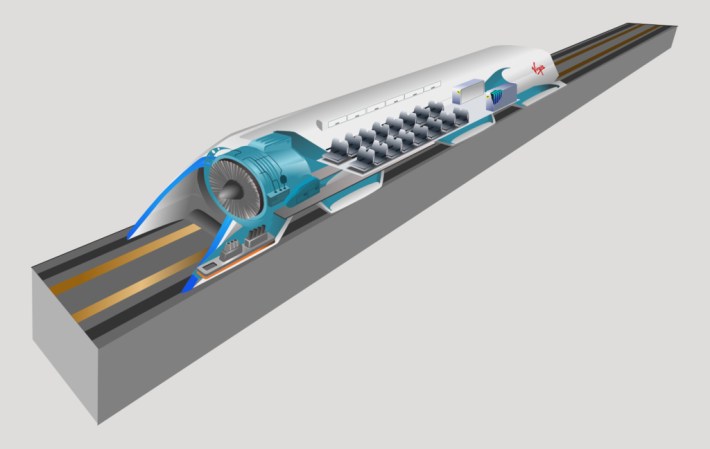
Hyperloop, Elon Musk's pitch for a transportation technology that he says will whisk people from somewhere north of Los Angeles to the East Bay in 35 minutes, was in the news again thanks to a two-day conference held at Texas A&M University. Engineering students from around the world displayed designs for a Hyperloop vehicle.
So what is a Hyperloop? And what does any of this mean for advocates for safe, sustainable transportation?
It shouldn't mean anything, because for now it's just a big experiment. Except that Musk sets the whole thing up as a challenge to California's statewide rail modernization and electrification project, also known as High-Speed Rail (HSR). HSR will bring clean, sustainable mass transit into the realm of city-to-suburb and city-to-city transportation. That's why it's getting funded in part by cap-and-trade proceeds. It will help fund Caltrain electrification and the connection to Transbay. It will replace many short-haul flights and cars for trips to and from Northern and Southern California and the cities of the Central Valley. So Musk, developer of the Tesla electric car and sometimes environmentalist, should be solidly behind it. Instead, here's the start of his introductory paper for Hyperloop:
How could it be that the home of Silicon Valley and JPL – doing incredible things like indexing all the world’s knowledge and putting rovers on Mars – would build a bullet train that is both one of the most expensive per mile and one of the slowest in the world? Note, I am hedging my statement slightly by saying “one of”. The head of the California high speed rail project called me to complain that it wasn’t the very slowest bullet train nor the very most expensive per mile. The underlying motive for a statewide mass transit system is a good one. It would be great to have an alternative to flying or driving, but obviously only if it is actually better than flying or driving. The train in question would be both slower, more expensive to operate (if unsubsidized) and less safe by two orders of magnitude than flying, so why would anyone use it?
Basically, everything he wrote about it is empirically false. Of course it's "better" than driving—just using existing HSR tech, in operation throughout the world, trip times from LA to San Francisco will take two hours and forty minutes. Musk's car, the Tesla, can't go anywhere near that fast—legally or otherwise. It also doesn't have enough juice in its batteries to make the trip. And electric cars sit in traffic jams, just like other cars--trains don't. As to subsidies, his companies take billions from the government. And his question, "why would anyone use it?" They already do use the trains, all throughout the world. The safety statement is also misleading poppycock
A little further in, he writes “The key advantages of a tube [meaning his hyperloop] vs. a railway track are that it can be built above the ground on pylons.” Has he never seen BART? Conventional trains run on the ground when they can because it's cheaper—there's no reason a conventional train can't also run on a pylon. In fact, there are already some HSR pylons in the ground in the Central Valley. He claims that the Hyperloop can be built for less than one-tenth of California's HSR project. That's another absurd claim, especially considering he doesn't even have a prototype.
It should be noted that, aside from the branding, Hyperloop isn't new--it's a variation on the “vacuum train,” first described by rocket pioneer Robert Goddard in 1910. The idea is to run a pressurized pod inside a huge tube that stretches from city to city. Giant pumps pull the air out of the tube, creating a complete or partial vacuum--and permitting jet airplane like speeds at ground level. But it's never escaped the realm of pop science because the engineering costs and complications just make it impractical. And while Musk has proposed some solutions, there's a huge amount of work to be done to see if they have any chance of working.
Unfortunately, as a previous post explained, there's a tendency for publications to simply latch on to anything a creative innovator and businessman of Musk's stature says, skepticism not required. But they should be skeptical: even the genius Nicola Tesla, the namesake of Musk's car company, had some crazy ideas that failed.
Either way, there's been enough misinformation about California's rail modernization efforts--the state doesn't need Musk sowing more of it.





